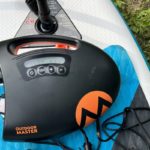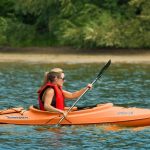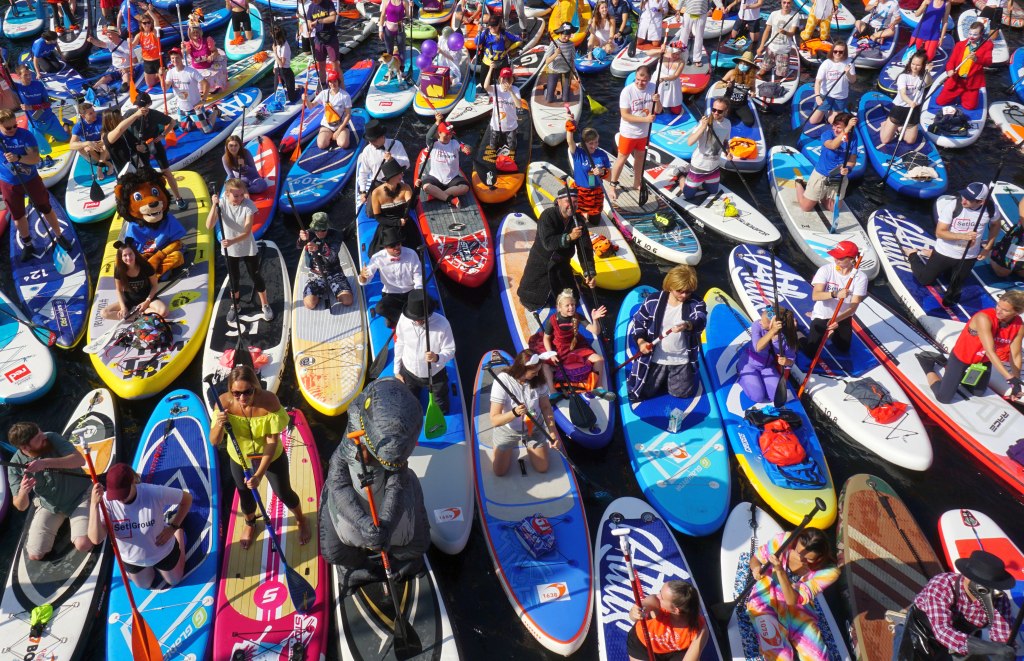OutdoorMaster Shark II is a truly reliable, hard-working, long-lasting pump. Here is our detailed review of this quick, easy, and highly efficient machine.
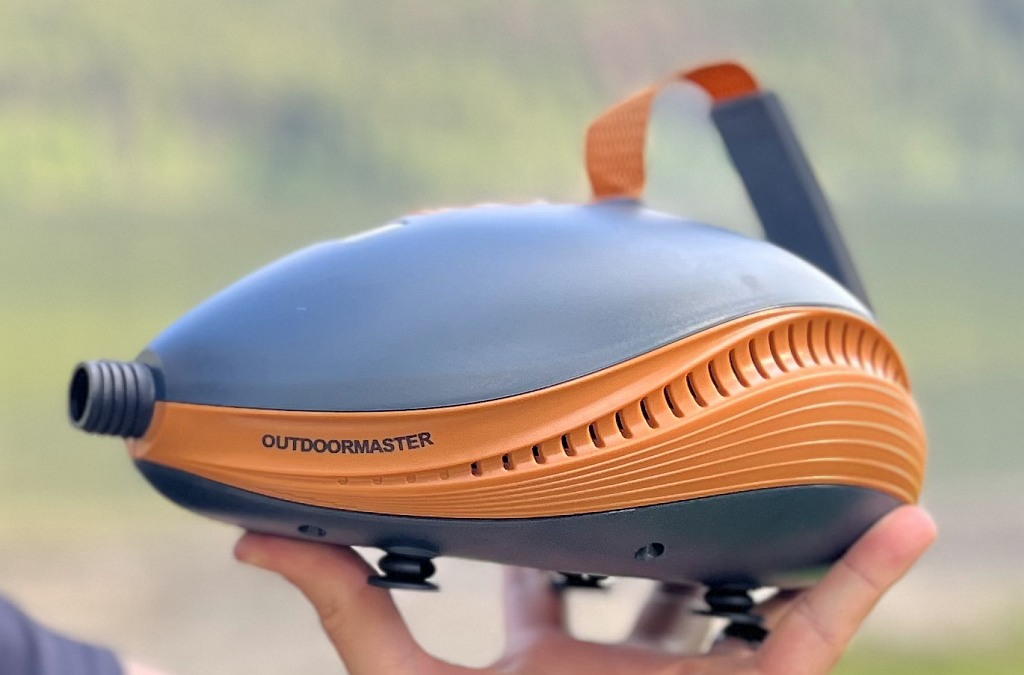
There’s nothing I love more at the end of a long work day than popping out for a quick paddleboarding trip at a nearby lake or river.
It’s magic, I tell you. Wipes all that stress right away, leaving me relaxed and happy.
But there’s just one downside: I have to spend so much time and effort inflating my paddleboards that by the time I’m actually out on the water, I’m too tired to enjoy it.
So when my wife bought me the OutdoorMaster Dolphin SUP pump, I was over the moon!
As you’ll read in my review below, this little pump makes for the ideal addition to our trimmed-down paddling gear. Small enough to fit anywhere but powerful enough to get the job done, it’s the pump I pack any and every time I want a quick paddling trip.
Sure, it’s got a couple of minor drawbacks, but at the end of the day, it’s a reliable, affordable option that performs surprisingly well for its small size.
Keep reading for an in-depth look at everything you need to know about the OutdoorMaster Dolphin SUP Pump.
As an affiliate of Amazon and other retailers, we may earn a small commission when you buy via our links, at no additional cost to you. Thank you!
What You Need to Know
| Inflation Speed: | Around 14 minutes to inflate an average-sized SUP |
| Display: | LCD Digital Display |
| Max PSI: | 20 PSI |
| Power Source: | Only 12V DC connector (includes a 12A fuse so it won’t damage your car) |
| Warranty: | 2 years |
| Decibels: | 70 db |
| Safety Features: | Auto shutoff |
Technical Specifications
| Weight: | 2.9 pounds (1.32 kg) |
| Size: | 10.2 x 6.7 x 6.6 inches (25.9 x 17 x 16.7 cm) |
| Nozzles: | HR/H3, C7, Pinch, Boston, and 805 Valve |
| Max Energy Consumption: | 10A, 120W (12V), DC |
| Pumping Speed: | 40L/Min |
| Power Cord Length: | 9ft (2.75 m) |
| Hose Length: | 4.5ft Hose (1.35 m) |
| Supported Pressure Range: | 0.5-20 PSI (0.034-1.378 Bar) |
| Digital Sensor Accuracy: | 0.01 PSI |
What’s in the Package?
From the moment I opened the box, it was pretty clear to see everything inside:

The box comes with the pump (wonderfully compact compared to the others I’ve tested), the 9 foot power cable (not attached, as you’ll see explained below), the 4.5-foot hose, the instruction manual, and the six nozzles.
Here’s what all the contents look like unpacked:

As you can see by this image from the manufacturer’s website, the pump includes six nozzles:
- Halkey-Roberts/H3 nozzle, the nozzles utilized by vast majority of SUPs on the market.
- C7 nozzle, the nozzle utilized on many high-performance inflatables (i.e. NRS’ rafts or catarafts).
- Pinch nozzle, which is utilized on inflatable mattresses, pool toys, floating islands, and other low-pressure inflatables.
- 805 nozzle, a nozzle crafted for high-speed inflation, typically utilized on inflatable boats and air beds.
- Boston nozzle, a nozzle utilized for the sort of two-way valves typically found on air mattresses and inflatable boats. The nozzle comes in two sizes, making it compatible with a wider range of inflatables.
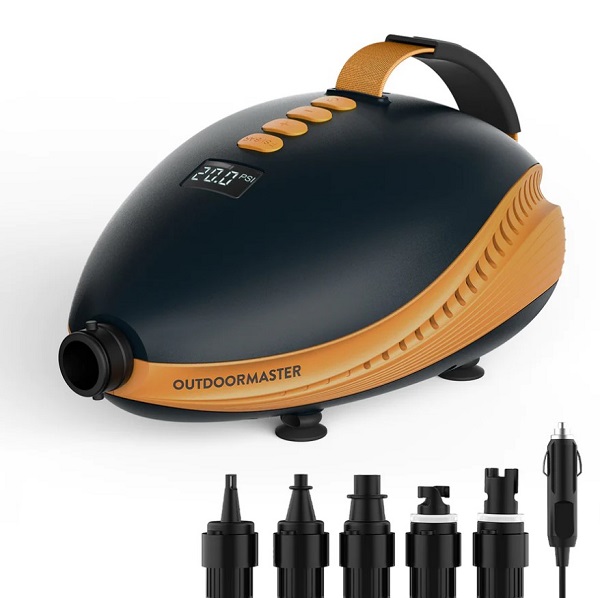
I’ve used a number of the nozzles—for example, the Boston nozzle to inflate my Nemo Roamer Sleeping Pad or the Pinch nozzle to inflate my Tobin Sports Lake Day 6-person Inflatable Party Island.
But at the end of the day, the nozzle that matters most is the Halkey-Roberts/H3 nozzle, which is used for pretty much all the SUPs on the market, including:
- Isle
- iRocker
- Hydro-Force
- ROC
- Blackfin
- Sea Lion
- Shark SUP
- Fanatic
- Red Paddle
- Hero Gladiator
- Nixy
- Bote
- Thurso
- Penguin
- Bluefin
- Atoll
- Body Glove
- Advanced Element
- Focus Hawaii
Still, having so many nozzles included with the pump is great because it makes it useful for quite literally anything that you need to inflate. I’ve taken the Dolphin on multiple camping trips, and it’s saved me from having to use a foot pump or hand pump to blow up my air mattresses, floating islands, and inflatable kayaks as well as my SUPs.
Plugging It In
Something that surprised me about the Dolphin is that the cord isn’t hard-wired into the body.
Every other SUP pump I’ve tested has the cord pre-connected, but the Dolphin’s comes separate. Before you can use it, you have to connect it into the pump using this odd-looking plug:

This was the first drawback to the Dolphin that I encountered.
When I went to plug it in, the plug didn’t quite fit into the socket easily. As a big, strong guy, I tend to break things very easily, so I was super leery about breaking it.
Thankfully, I got the plug into the socket without forcing or snapping anything. But it definitely has me worried that over the course of a few months or years, I will end up breaking it. And if not me, my less-than-cautious-when-in-a-hurry teenagers.
Once it was connected, it was a simple matter of plugging the other end of the cable into my car’s 12V power supply, and we were off to the races.
One strong “pro” about this particular pump is that it has a longer-than-average cable. While many I’ve used have only a 6-foot cable, the OutdoorMaster Dolphin has a 9-foot cable.
That way, when I’m setting up the SUP to inflate, I’ve got plenty of length to play with.
In my Toyota Corolla, the 12V plug is in the center console armrest rather than beneath the steering wheel. So that little bit of extra cord length makes it easy for me to run the power cord that extra distance to where my SUP is set up right outside my car door.
I’ve also got even more length if I want to set up a tarp or inflate my SUP on the grass—somewhere other than on the sun-baked concrete next to my car.
There is another drawback to the Dolphin that I want to mention here: it’s only compatible with a 12V power supply.
Some pumps come with other sources of power—for example, the iRocker Electric Pump is battery powered (both internal battery and external additional battery), while the OutdoorMaster Whale can be plugged into a 110V power socket for easier pumping when at home or a campsite that has electricity.
However, I’d say roughly 75% of the SUP pumps on the market are, like the Dolphin, designed to only use 12V power supply. So it’s not a huge drawback, really more of an “I wish this already great pump was even better in this small way”.
Carrying It Around
One thing that instantly appealed to me about the OutdoorMaster Dolphin is that it’s wonderfully small and portable.
At under 3 pounds and 10.2 x 6.7 x 6.6 inches (25.9 x 17 x 16.7 cm) in size, it’s small enough that I can pack it into my camping gear totes or slide it into a corner of my Corolla’s trunk.
I even can fit it into my paddle board backpack, hose and cord and all, because of how compact it is.
The handle is a canvas strap with a rubber grip that’s easy to hold.

I hauled this pump around over an entire weekend of camping and paddleboarding, and I barely noticed its weight.

It’s one of the smallest and lightest pumps I’ve tested to date, extremely portable but (as you’ll see in the next section) still packs pretty decent power all things considered.
Inflation Speed
If you read my review of the OutdoorMaster Shark II, you’ll know that I’m obsessed about testing and getting accurate data—especially when it comes to inflation time.
After all, if it takes an electric pump longer to fill the paddleboard than I’d manage by hand, then the pump isn’t quite as useful as it should be. It’s intended to be an item of convenience, reducing both the time and effort invested into inflating my SUP.
So I needed to test to make sure it gets the job done faster and with less work than the two-way hand pumps included with all inflatable SUPs.
One significant difference to note right off the bat with the Dolphin (compared to other OutdoorMaster pumps and pumps from other brands) is that it’s not a dual-stage pump.
Most electric SUP pumps operate in two stages:
- Stage #1: High Volume – Typically ranging between 250 and 350 liters per minute, Stage 1 is intended to inflate the board quickly with maximum air output but minimal pressure.
- Stage #2: High Pressure – Once the pump reaches a certain PSI (usually between 0.5 and 1.5), it’ll switch to generating lower air flow (usually 50 to 70 liters per minute) but at higher pressure. The remaining inflation is slower, but it’s this high-pressure stage that gets it up to your desired PSI.
When I first set up the Dolphin, I set my timer to see how long it would take not only to inflate my SUP completely, but how long it would take to switch from Stage #1 to Stage #2.
I should have paid closer attention to the specs.
It turns out the Dolphin is a single-stage pump. What this means is that it’s always operating in high-pressure mode. It’ll continually pump air at a lower output but with power enough to inflate to high PSI without having to switch between stages.
Knowing this, I sat back and waited for the pump to finish filling my SUPs.
The first SUP is connected was a 10’ 10” (330.2 cm) , the board I typically use out on the water:

I like to inflate mine a little more (to 15.5 or 16 PSI) to ensure it’s as stiff and rigid as possible to accommodate my above-average height and weight.
But for the sake of consistency, I plugged the Dolphin into my car’s 12V power supply, set it to 15 PSI, and waited.
And waited. And waited.
Because of its small size, the Dolphin is only capable of producing 40 liters per minute of high-pressure air flow. That is notably below average (the Shark II, for example, produces 70 liters per minute in the high-pressure Stage #2).
I stopped the clock when the pump finally reached 15 PSI, and you can see the time:

Roughly 14½ minutes? That’s about 2 minutes slower than the Shark II, and at least 5 minutes slower than it would have taken me to inflate the SUP by hand.
Just to make sure I had accurate data, I set it to inflate a second board (this one an 11-footer).

Instead of connecting it to my car, though, I plugged it into a portable battery bank (GoSun’s 266wh Portable Solar Power Bank) just to see if it would speed up or slow down the inflation time.
As you can see below, the results were nearly identical:

Around 14½ minutes to inflate the board from totally empty to 15 PSI.
Definitely not the fastest-working pump around. But I suppose that’s to be expected given its compact size.
Important Safety Features
After reviewing the OutdoorMaster Shark II, I was surprised to see the Dolphin didn’t include the Active Frost Cooling system integrated into the larger pump. It’s a critical safety feature that claims to make the Shark II capable of inflating 3 boards back to back without needing time to cool off.
But on studying the specs of the Dolphin, I found it’s said to be capable of inflating up to 10 SUPs consecutively without needing rest.
Yes, you read that right: ten SUPs!
I have yet to see a pump that can operate that continuously without burning out. Most need a break after 3 or 4. But 10?
I don’t have 10 paddleboards to test it out on, so I couldn’t put that claim to the test. But I will say that after inflating a third paddleboard (after the two I tested above), I couldn’t feel any excessive heat radiating from the pump.
On the Shark II, after running for a long time, I could feel the motor heating up even through the plastic body casing. But the Dolphin was barely warm to the touch. Suffice it to say, I was impressed—and perhaps convinced it actually can inflate 10 SUPs in a row as it claims.
But even if it can’t, the ability to inflate 5-8 instead of the standard 2-3 SUPs without needing a break is definitely a huge “pro” for the Dolphin.
Another great safety feature incorporated into the pump is the 12-amp fuse. The integrated fuse stops a surge of electrical current from damaging the pump, but also prevents a short-circuit in the pump from damaging my car’s electrical system.
It’s a feature incorporated into all the OutdoorMaster electrical SUP pumps—and one I’m very grateful for.
How High Can It Go?
The OutdoorMaster Dolphin can inflate your SUPs up to 20 PSI, but can also operate as low as 0.5 PSI.
The slower-than-average fill speed means it’ll take longer to inflate, say, a pool toy or air mattress (which I found when I filled my Nemo Roamer Sleeping Pad and it took nearly 5 minutes of continuous operation to fully inflate).
But because it’s consistently operating at high pressure, it’ll generate a slow and steady output of air that won’t risk bursting lower-pressure inflatables.
Typically, SUPs are inflated to around 15 PSI (the range is 13 to 17), but some high-end inflatables (such as motorized inflatable boats or catarafts) need to be taken as high as 20 PSI.
Save Time With the Auto Shut-Off
This is one of my favorite features of the Dolphin (and most electric SUP pumps).
When I first get to the lake, river, or beach, I’ll plug in the pump to my car’s 12V power, set it to my desired PSI, and let it get to work. While it’s pumping away, I can unload the rest of my camping gear, trusting that the pump will shut off when it hits the target PSI.
I’ve never once had to worry about the pump over-filling my SUPs. It’s easy to adjust—just raise or lower the target PSI using the “+” and “-“ buttons.
I don’t even need to watch the numbers ticking up slowly on the LCD screen because I know it’ll automatically stop pumping when it reaches the PSI I’ve set it to.
How Noisy is It?
Here’s another reason to love the Dolphin: it’s quieter than almost any other electric pump I’ve tested.
While most other electric pumps operate fairly quietly (around 40 to 60 db) during the high-volume Stage #1, they really ratchet up the noise during the high-pressure Stage #2.
Typically, most electric SUP pumps generate between 80 and 100 db during their noisier stage. According to Yale University, that noise level is comparable to:
- Telephone dial tone (80 db)
- City traffic (85 db)
- A subway train at 200 feet (95 db)
Hearing loss usually occurs after frequent and prolonged exposure to sounds in the 80 to 90 db range. I never run my electric SUP pump long enough to ever suffer actual hearing problems, but my ears are usually ringing if I stand too close to most SUP pumps while they’re running on the noisy Stage #2.
But the Dolphin runs at 70 db—which is quieter than the average vacuum cleaner.
If I run it next to my car, I’ll barely hear it when I’m hauling my gear to my campsite 50 to 100 feet away. If I run it at my campsite (hooked up to my portable battery), I can still carry on a conversation or read a book without the noise being annoying or uncomfortable.
Definitely a “win” as far as I’m concerned!
Inflation Only
This is one of the “cons” of the Dolphin.
While most of the electric SUPs on the market feature both an inflation and deflation setting, the Dolphin is only capable of inflation.

I don’t typically use the deflation setting with my SUPs, but I do use it when putting away my sleeping pad, air mattress, and other inflatables that I want to pack up as small as possible to fit in my camping gear totes.
The lack of deflation setting isn’t a deal-breaker for me—it’s more a “nice-to-have” rather than a “must-have”.
Warranty
OutdoorMaster offers a 2-year warranty on the Dolphin (and all the rest of its SUP pumps). This is slightly better than average, I’ve found.
Most “cheap” (aka, lower quality) brands will offer a 90-day, 6-month, or 1-year warranty. Sometimes no warranty at all.
The higher-end brands will usually go for a 1-year or 2-year warranty. It’s extremely rare that a SUP pump is backed by a longer warranty simply because it’s expected that prolonged and frequent use will eventually cause the delicate motor to burn out after a few years of use.
But having testing out the Dolphin (and other OutdoorMaster pumps), it’s easy to see why the brand is confident enough that it will last at least 2 years to back it up with a warranty to match. I’ve used it for just a few months, but it has yet to show any signs of wear and tear, slowing, or burning out.
How Does It Compare to Other OutdoorMaster SUP Pumps?
| Dolphin II | Shark II | Whale | Cachalot | |
| Weight: | 2.93 lbs. (1.27 kg) | 3.6 lbs. (1.63 kg) | 7.5 lbs. (3.4 kg) | 4.73 lbs. (2.15 kg) |
| Size: | 10.31 x 6.89 x 6.46 inches (25.9 x 17 x 16.7 cm) | 12.48 x 10.55 x 7.24 inches (31.7 x 26.8 x 18.4 cm) | 16.1 x 11.5 x 7 inches (40.9 x 29.2 x 17.78 cm) | 14.25 x 7.17 x 7.09 inches (36.2 x 18.2 x 18 cm) |
| Power Source: | 12V DC | 12V DC | 12V DC, 6000 mAh battery, 110V power supply | 12V DC |
| Pumping Speed: | 40/L min | 350L/min at 1st Stage70L/min at 2nd Stage | 350L/min at 1st Stage70L/min at 2nd Stage | 350L/min at 1st Stage70L/min at 2nd Stage |
| Dual Inflators Switch Point: | N/A | 1 PSI (0.07 bar) | 1 PSI (0.07 bar) | 1 PSI (0.07 bar) |
| Supported Pressure Range: | 0.5-20 PSI (0.034-1.378 Bar) | 0.5-20 PSI (0.034-1.378 Bar) | 0.5-16 PSI (0.034-1.103 Bar) | 0.5-20 PSI (0.034-1.378 Bar) |
| Notable Features: | Compact enough to fit in SUP backpacks | Pump up to 3 boards without stopping | USB port charger + LED light | Ultra-sturdy and stable design |
| Price: | $59.99 | $103.89 | $194.97 | $89.99 |
My Conclusions
After testing the OutdoorMaster Dolphin first-hand, I’ve come to the conclusion that though it is small, it is surprisingly mighty.
Sure, the inflation time was a bit slower than I’d like (14 ½ minutes). However, comparing it to the 12 ½ minutes OutdoorMaster’s Shark II (a much chunkier, heavier-duty pump) took to inflate the same paddleboards, the result isn’t exponentially slower.
Neither the potentially fragile connector or the lack of a deflation setting were dealbreakers, either.
Because there was a lot to love about this little pump, including its compact size (which makes it possible to pack directly in my SUP backpacks), low noise output, and reliable performance.
And if I ever need a pump to fill a whole fleet of paddleboards for my family, the fact that this pump claims to be able to work for 10 SUPs back to back is definitely a “win” in my book.
Best of all, it’s one of the most affordable SUP pumps on the market, but is built with OutdoorMaster’s quality and backed by a 2-year warranty.

